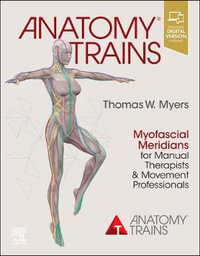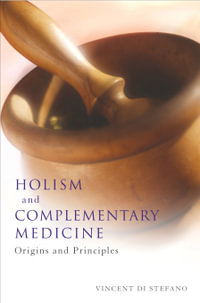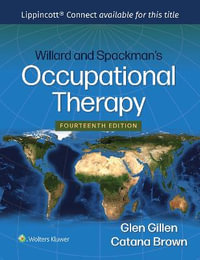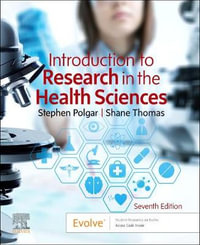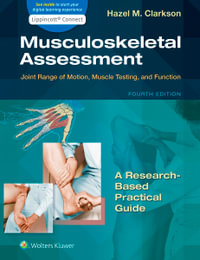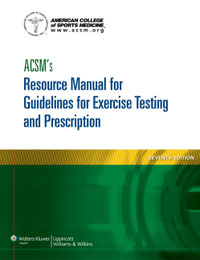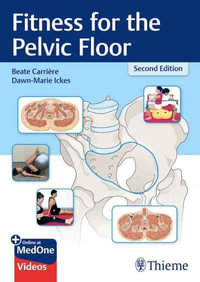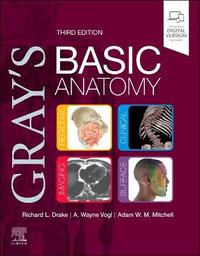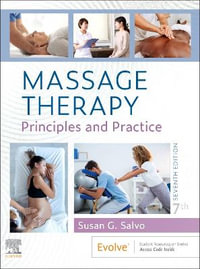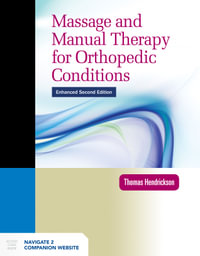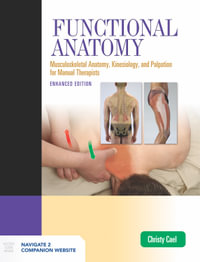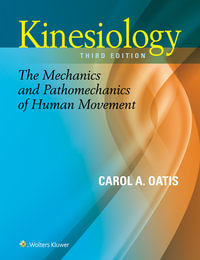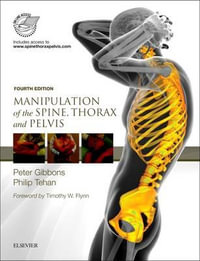
The Shoulder in Sport
Management, Rehabilitation and Prevention
By: Andrea Fusco
Hardcover | 28 December 2007
At a Glance
348 Pages
26.04 x 20.32 x 1.91
Hardcover
RRP $107.95
$87.95
19%OFF
or 4 interest-free payments of $21.99 with
orAims to ship in 5 to 10 business days
Highly topical subject, considering the increase in the practice of amateur sports and the demand of high level performances in professional sports activitiesMultidisciplinary approach by opinion leaders and specialists in the pathology of the shoulder at different levels (diagnostic, medical, surgical and rehabilitative therapy of articular, muscle and tendinous pathologies).
| Contributors | p. xi |
| Abbreviations | p. xiii |
| About the Editors | p. x |
| Preface | p. xv |
| Functional anatomy and recent biomechanical discoveries | |
| Anatomical variants of the shoulder | p. 3 |
| Glenohumeral joint | p. 3 |
| Bone structures of the glenohumeral joint | p. 3 |
| Soft tissues of the glenohumeral joint | p. 4 |
| Coracoacromial arch | p. 9 |
| Bone structures of the coracoacromial arch | p. 9 |
| Soft tissues associated with the coracoacromial arch | p. 14 |
| Acromioclavicular joint | p. 15 |
| Bone structures of the acromioclavicular joint | p. 15 |
| Soft tissues of the acromioclavicular joint | p. 17 |
| Sternoclavicular joint | p. 17 |
| Bone structures of the sternoclavicular joint | p. 17 |
| Soft tissues of the sternoclavicular joint | p. 17 |
| Neurovascular bundle and adjacent structures | p. 18 |
| Conclusions | p. 21 |
| Bibliography | p. 21 |
| Biomechanics of the shoulder | p. 25 |
| Stability of the glenohumeral joint | p. 25 |
| Congruency of the joint heads | p. 25 |
| Joint orientation | p. 26 |
| Negative intra-articular pressure | p. 27 |
| Labrum | p. 27 |
| Capsuloligamentous complex | p. 28 |
| Active stabilization | p. 29 |
| Conclusions | p. 31 |
| Elevation of the arm | p. 31 |
| Osteokinematics | p. 31 |
| Glenohumeral osteokinematics | p. 31 |
| Scapulothoracic osteokinematics | p. 32 |
| Osteokinematics of the clavicle | p. 32 |
| Arthrokinematics | p. 32 |
| Glenohumeral arthrokinematics | p. 32 |
| Throwing movements | p. 33 |
| Kinematics of throwing | p. 33 |
| Kinetics of throwing | p. 34 |
| Bibliography | p. 36 |
| Pathology, clinical aspects and diagnostic imaging | |
| Premise | p. 41 |
| Examination of the painful shoulder: interdisciplinarity and clinical rationale | p. 41 |
| Bibliography | p. 43 |
| Shoulder instability | p. 45 |
| Aetiopathogenesis | p. 45 |
| Structural factors and principles of classification | p. 46 |
| Functional factors and athletic actions | p. 47 |
| Athletic actions below 90[degree] of abduction | p. 50 |
| Athletic actions above 90[degree] of abduction (overhead) | p. 50 |
| Ballistic sports and conditions prejudicial to stability | p. 52 |
| Conclusions | p. 53 |
| Acknowledgements | p. 55 |
| Bibliography | p. 55 |
| Impingement syndromes: definition and classification | p. 57 |
| Aetiopathogenesis | p. 58 |
| Structural factors | p. 58 |
| Functional factors | p. 62 |
| Principles of classification | p. 66 |
| Conclusions | p. 67 |
| Unresolved problems for research | p. 68 |
| Further reading | p. 68 |
| Bibliography | p. 69 |
| Epidemiology of shoulder lesions in sport | p. 71 |
| Types of lesion | p. 71 |
| Glenohumeral instability | p. 71 |
| Lesions of the glenoid labrum | p. 72 |
| Impingement | p. 72 |
| Exostosis | p. 72 |
| Vascular pathology | p. 72 |
| Nerve pathology | p. 73 |
| Fractures | p. 73 |
| Types of sports | p. 73 |
| Volleyball | p. 73 |
| Tennis | p. 73 |
| Baseball and softball | p. 74 |
| Water polo | p. 75 |
| Swimming | p. 75 |
| Gymnastics | p. 76 |
| Golf | p. 76 |
| Bibliography | p. 76 |
| Specialist examination | p. 79 |
| History | p. 79 |
| Objective examination | p. 80 |
| Inspection | p. 80 |
| Palpation | p. 80 |
| Mobility | p. 80 |
| Specific functional tests | p. 81 |
| Discussion | p. 87 |
| Bibliography | p. 88 |
| Diagnostic imaging | p. 89 |
| Technical principles and radiological anatomy | p. 90 |
| Conventional radiology | p. 90 |
| Ultrasound | p. 92 |
| Magnetic resonance | p. 93 |
| Computed tomography | p. 94 |
| Arthrographic techniques | p. 94 |
| Rotator cuff | p. 94 |
| Osteomedullary trauma | p. 98 |
| Instability | p. 99 |
| Calcific enthesopathy, tendinitis and bursitis | p. 102 |
| Nerve entrapment syndromes | p. 103 |
| Osteolysis of the clavicle | p. 104 |
| Soft tissues | p. 104 |
| Bibliography | p. 106 |
| Functional examination as part of manual therapy | p. 107 |
| History and objective examination | p. 108 |
| Self-assessment questionnaires | p. 111 |
| Functional examination | p. 114 |
| Inspection | p. 115 |
| Evaluation of movement | p. 117 |
| Evaluation of strength | p. 125 |
| Palpation | p. 128 |
| Disorder-targeted tests | p. 128 |
| Notes on the functional examination of athletes | p. 132 |
| Conclusions | p. 132 |
| Bibliography | p. 133 |
| Surgical treatment | |
| Inclusion criteria for surgical treatment | p. 143 |
| The doctor, the athlete and the injury | p. 144 |
| Which type of surgery is indicated? | p. 144 |
| What type of patient is eligible? | p. 145 |
| When to operate | p. 146 |
| Scapulohumeral disorders | p. 146 |
| Instability | p. 146 |
| Disorders of the subacromial space | p. 148 |
| Conclusions | p. 149 |
| Bibliography | p. 149 |
| Surgical solutions in joint disorders | p. 151 |
| SLAP lesion | p. 151 |
| SLAC lesion | p. 152 |
| Ganglion cyst associated with SLAP | p. 152 |
| Anterior instability | p. 153 |
| Bony Bankart lesion | p. 154 |
| Posterior instability | p. 156 |
| Posterosuperior impingement | p. 157 |
| Cartilage erosion | p. 158 |
| Bibliography | p. 158 |
| Surgical solutions in muscle and tendon disorders | p. 161 |
| Classification of rotator cuff lesions | p. 161 |
| Duration of the symptoms | p. 161 |
| Site of the lesion | p. 161 |
| Degree of reparability | p. 162 |
| Decision-making strategy for repairing the rotator cuff | p. 163 |
| Surgical technique | p. 164 |
| Positioning the patient | p. 164 |
| Portals | p. 164 |
| Initial phase of arthroscopy and evaluation of damage | p. 165 |
| Lesions of the subscapularis | p. 165 |
| Portal placement for the subacromial space | p. 165 |
| Preparation and evaluation of the lesion | p. 165 |
| Positioning of the anchors | p. 166 |
| Acromioplasty | p. 167 |
| Postoperative management | p. 167 |
| Bibliography | p. 167 |
| Rehabilitation, training and prevention | |
| Rehabilitation: cultural models, working models and scope | p. 171 |
| Use of the ICF in rehabilitation practice | p. 172 |
| Multidimensional load/carriability/adaptability model and the PHP | p. 172 |
| Choice of outcome | p. 173 |
| Physiotherapist's skills in the various areas of impairment, disability and problems of participation | p. 174 |
| Case report | p. 177 |
| Prognostic health profile | p. 177 |
| Therapy | p. 178 |
| Bibliography | p. 178 |
| Postoperative rehabilitation | p. 181 |
| Principles of rehabilitation | p. 181 |
| The rehabilitation protocol | p. 183 |
| Limits of healing | p. 183 |
| Surgical techniques and rehabilitation | p. 184 |
| Open capsulorrhaphy | p. 184 |
| Bristow procedure | p. 185 |
| Transposition of the subscapularis | p. 185 |
| Arthroscopic capsulorrhaphy | p. 185 |
| Thermal capsulorrhaphy | p. 185 |
| Surgery of the glenoid labrum | p. 186 |
| Biomechanical limits | p. 186 |
| Exercises | p. 187 |
| Postoperative treatment | p. 193 |
| Conclusions | p. 193 |
| Bibliography | p. 194 |
| Manual therapy in rehabilitation | p. 195 |
| Passive manual mobilization as a training stimulus: general principles | p. 195 |
| Grades of mobilization | p. 198 |
| Joint mobilization | p. 200 |
| Passive joint mobilization | p. 201 |
| The concave-convex rule | p. 203 |
| Mobilization techniques | p. 203 |
| Glenohumeral joint | p. 203 |
| Scapulothoracic joint | p. 210 |
| Acromioclavicular joint | p. 212 |
| Sternocostoclavicular joint | p. 213 |
| Conclusions | p. 215 |
| Acknowledgements | p. 216 |
| Bibliography | p. 216 |
| Therapeutic exercise in rehabilitation | p. 217 |
| Multidimensional load/carriability model | p. 219 |
| Carriability and determining exercise load | p. 221 |
| Pain as impairment | p. 221 |
| Motor control as impairment | p. 223 |
| Mobility as impairment | p. 231 |
| Proprioception as impairment | p. 232 |
| Psychosocial factors and impairment | p. 233 |
| Proposals for the future | p. 233 |
| Acknowledgements | p. 234 |
| Bibliography | p. 234 |
| Prevention and physical and athletic training | p. 239 |
| The meaning of prevention | p. 239 |
| Athletic training and classification of sports | p. 240 |
| Relation between load and carriability: overuse syndrome and overtraining | p. 242 |
| Periodization and monitoring of athletic training | p. 244 |
| Methodology and objectives of athletic training | p. 245 |
| Organic and muscular objectives of athletic training | p. 245 |
| Muscle strength | p. 245 |
| Resistant strength | p. 247 |
| Joint mobility and muscle extendibility | p. 247 |
| Neuromuscular objectives of athletic training | p. 249 |
| Proprioception | p. 249 |
| Muscle balance and joint stability | p. 250 |
| Specificity of athletic training | p. 250 |
| Acknowledgements | p. 250 |
| Bibliography | p. 251 |
| Prevention and technical athletic evaluation | p. 253 |
| Evaluation and technical athletic observation | p. 253 |
| Evaluation and functional observation | p. 253 |
| Identification of limits in athletic training | p. 254 |
| Identification of limits in the periodization of training | p. 255 |
| Identification of limits in the training methodology | p. 255 |
| Identification of limits in organic and muscular capacities | p. 257 |
| Identification of limits in neuromuscular capacities | p. 258 |
| Identification of limits in ballistic actions | p. 260 |
| Recommendations for the evaluation of limits in technical actions | p. 260 |
| Acknowledgements | p. 263 |
| Bibliography | p. 263 |
| Current trends in surface electromyography | |
| Surface electromyography | p. 267 |
| The surface EMG signal: basic concepts | p. 268 |
| Variables and parameters of the EMG signal | p. 270 |
| Myoelectric signs of fatigue | p. 272 |
| Conclusions | p. 274 |
| Bibliography | p. 276 |
| Atlas of the innervation zones of the superficial muscles of the shoulder | p. 279 |
| Bibliography | p. 281 |
| Practical applications in surface electromyography: literature review | p. 297 |
| Physiological studies | p. 298 |
| Shoulder disorder studies | p. 300 |
| Impingement | p. 300 |
| Shoulder instability | p. 302 |
| Applications in physiotherapy | p. 303 |
| Studies in specific sports | p. 304 |
| Bibliography | p. 305 |
| Glossary | p. 307 |
| Bibliography | p. 311 |
| Colour Plates | p. 313 |
| Index | p. 317 |
| Table of Contents provided by Ingram. All Rights Reserved. |
ISBN: 9780443068744
ISBN-10: 0443068747
Published: 28th December 2007
Format: Hardcover
Language: English
Number of Pages: 348
Audience: Professional and Scholarly
Publisher: Churchill Livingstone
Country of Publication: GB
Dimensions (cm): 26.04 x 20.32 x 1.91
Weight (kg): 0.95
Shipping
| Standard Shipping | Express Shipping | |
|---|---|---|
| Metro postcodes: | $9.99 | $14.95 |
| Regional postcodes: | $9.99 | $14.95 |
| Rural postcodes: | $9.99 | $14.95 |
How to return your order
At Booktopia, we offer hassle-free returns in accordance with our returns policy. If you wish to return an item, please get in touch with Booktopia Customer Care.
Additional postage charges may be applicable.
Defective items
If there is a problem with any of the items received for your order then the Booktopia Customer Care team is ready to assist you.
For more info please visit our Help Centre.
You Can Find This Book In

Cardiorespiratory Physiotherapy: Adults and Paediatrics
Adults and Paediatrics with PAGEBURST Access, 5th Edition
Paperback
RRP $90.95
$69.95
OFF

Functional Anatomy
Musculoskeletal Anatomy, Kinesiology, and Palpation for Manual Therapists : 2nd Edition
Paperback
RRP $189.95
$113.90
OFF


